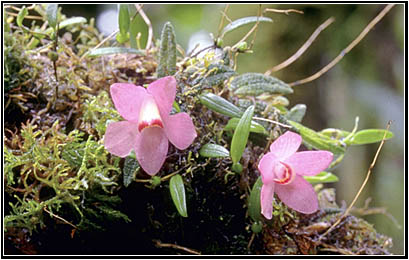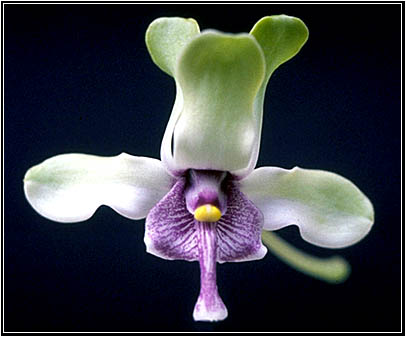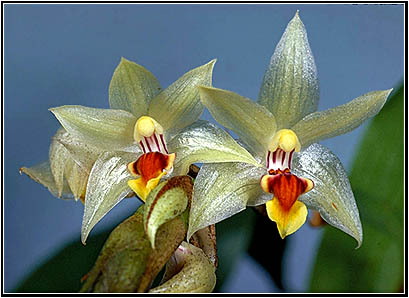|
Orchids
of Southeast Asia on CD-ROM
Interview with Andre Schuiteman, also on behalf of Ed de Vogel
André
Schuiteman is taxonomist and currently a staff member of
the National Herbarium of the Netherlands and the main author
of the CD-ROM series Flora Malesiana: Orchids of New Guinea.
He visited Tanzania, Colombia, Malaysia, Indonesia and Papua
New Guinea to study the local orchid flora.
Ed de Vogel was until his retirement in 2004 senior researcher
at the National Herbarium of the Netherlands in Leiden.
He has done fieldwork throughout Indonesia as well as Malaysia,
the Philippines and Brunei.
He was founder and editor of the now discontinued journal Orchid
Monographs and he is second author of the CD-ROM series Flora
Malesiana: Orchids of New Guinea.
|
|
 Ed de Vogel
Ed de Vogel |
ON: How long have you been working on the orchids from the SouthEast
Asia?
AS: Ed de Vogel has been working on and off
on orchids since about 1968, when he started a revision of the genus
Apostasia. Since 1980 he has devoted almost all his time on
Southeast Asian orchids. As for me, I have always been interested
in any kind of orchid since I was twelve years old, which was around
1973. My scientific work on Southeast Asian orchids begun in 1982
when I first visited Papua New Guinea.
ON: What is exactly this work? Which is or are the mainly differences
from this work to the traditionnal ones?
AS: There is an international project called
the Flora Malesiana project, which aims to describe all the flowering
plants and ferns from the Malesian region. This is a part of Southeast
Asia. More precisely, Malesia covers the territories of the following
countries: Malaysia, Indonesia, the Philippines, Papua New Guinea,
Singapore, Brunei and Timor. In this region there are probably more
than 5000 orchid species. In view of the fact that many of these are
seriously threatened by habitat destruction, Ed and I thought that
it would be a great help for conservation if there was some kind of
preliminary treatment of all the orchids from this region, with lots
of illustrations. So about ten years ago we decided to start producing
a series of CD-ROMs in which all the known orchids of Malesia would
be described and illustrated. Now, writing a traditional flora treatment
of such a large group of plants would certainly take more than 150
man years. With the limited number of experts available that would
take so long that by the time the flora was completed most of the
species would probably have become extinct. What we are doing is a
more informal treatment, a synopsis of existing knowledge, filtered
and complemented by our own experience and expertise. And we get a
lot of help from other institutes, especially those in Kew, Edinburgh,
Port Moresby, Bogor, Singapore and Copenhagen. Also many experts,
both amateur and professional, make extremely valuable contributions
by sharing their images and knowledge with us.
ON: How many species it covers?
AS: Eventually more than 5000, perhaps even
as many as 6000.
ON: Which genera?
AS: There are about 210 orchid genera in the
Malesian region. The most important genera include Bulbophyllum,
Dendrobium, Eria, Dendrochilum, Coelogyne,
Liparis, Oberonia, etc. Some smaller, but horticulturally
important genera here are Phalaenopsis, Paphiopedilum,
Vanda, Aerides, and others.

Dendrobium
cuthbertsonii - photo by A. Schuiteman |
|
| |

Dendrobium
violaceo flavens
- photo by J. van Bodegom |
| |

Dryadorchis
dasystele - photo by de Vogel |
| |

Eria ramuana
- photo by Royal Botanic Garden Edinburgh |
ON: How many
CD do you intente to do? Are all of them already available?
AS: Hard to say how many. It also depends on future
technology, on how much information can be stored on a CD or DVD or
whatever. So far we have published three CD-ROMs on the orchids of New
Guinea, with three more to follow. And one on the orchids of the Philippines.
It all depends on finding more funds whether or not we will be able
to carry on after the New Guinea series is finished (which will treat
around 2700 species).
ON: How does it works?
AS: The CD-ROMs work on any normal PC with Windows
or on a Macintosh computer. They use a program called Linnaeus II,
which was developed by ETI at Amsterdam. It is highly interactive
and almost everything is cross-linked: images, descriptions, technical
terms, keys, references, etc. Each of our CD-ROMs would make a book
of at least a thousand pages when it would be printed in the usual
way, with about four images per page. Almost nobody would be able
to afford such a book, but at 59 Euro the CD-ROMs are relatively cheap
for the amount of information (and may I say entertainment) they have
to offer. If you love orchids you will love the CD-ROMS.
ON: How people can buy them?
AS: For ordering information please send an
e-mail to: publications@nhn.leidenuniv.nl
ON: Thank you very much, Dr. Andre Schuiteman
|
Any
kind of reproduction (print, digital or anyone other) of any
type of material of this site - texts, layout, photos, images
and others - is strictly forbidden without previous written
permission by the authors.
|

|




